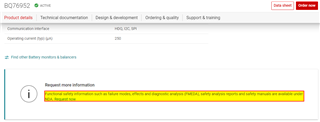Tool/software:
Hello
This extends James Tyou's question.
Some newer battery chemistries are safe to discharge to 0 volts; a similar problem to James' work with supercapacitors.
I'd like to allow these cells to 'bootstrap' up to the voltage that the BQ requires at the BAT supply pin.
I have modified the EVM circuit to also supply the BAT pin from the CD net through a diode (see below)

I was declined access to the Functional Safety analysis and no reason provided. Can TI provide advice if this connection would fail the analysis ?
I have a 3000W TVS at the pack pins with a clamping voltage below the discharge FET Vdsmax. A transient can still drive the CD pin up to that clamping voltage (less the FET diode drop) which D2, R1, and C1 must survive. I am unsure what the effect might be on functional safety.
All the best
Harry



